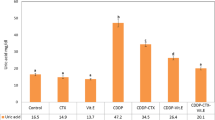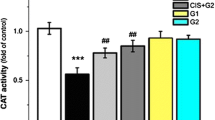Abstract
The objective of this study was to assess the therapeutic advantage of glutathione ester along with cisplatin. Comparisons were made with renal reduced glutathione, enzymatic antioxidants, and lipid peroxidation levels. Cisplatin caused differential toxic effects on renal antioxidants and lipid peroxidation. However administration of glutathione ester modulates the toxic effects of cisplatin observed in renal antioxidants and lipid peroxidation. The finding that glutathione ester co-administration along with cisplatin is more effective and advantageous in protecting against the nephrotoxicity of cisplatin when it was given alone.
Similar content being viewed by others
References
Rosecweig M, Von Hoff DD, Slavik M, Muggia FM: Cis-diamminedichloroplatinum (II): a new anticancer drug. Ann Int Med 86: 803–812, 1977
Gottlieb JA, Drewinko B: Review of the current clinical status of platinum coordination compounds in Cancer Chemotherapy. Cancer Chemother Rep 59: 621–628, 1975
Safirstein R, Winston J, Goldstein M, Moel D, Dikman S, Guttenplan J: Cisplatin nephrotoxicity. Amer J Kidney Dis VIII: 356–367, 1986
Daugaard G, Abildgaard U, Holstein-Rathlou NH, Bruunshuus I, Bucher D, Leyssac PP: Renal tubular function in patients treated with high dose cisplatin. Clin Pharmacol Ther 44: 164–172, 1988
Litterst CL: Alterations in the toxicity of cis-dichlorodiammine-platinum-II and in tissue localization of platinum as a function of Nacl concentration in the vehicle of administration. Toxicol Appl Pharmacol 61: 99–108, 1981
Harder HC, Rosenberg B: Inhibitory effects of antitumor platinum compounds on DNA, RNA and Protein syntheses in mammalian cellsin vitro. Int J Cancer 6: 207–216, 1970
Scanlon KJ, Safirstein RL, Thies H, Gross RB, Waxman S, Guttenplan JB: Inhibition of amino acid transport by cis-diamminedichloroplatinum (II) derivatives in L1210 murine leukemia cells. Cancer Res 43: 4211–4215, 1983
Dedon PC, Borch RF: Characterization of the reactions of platinum antitumor agents with biologic and nonbiologic sulfur-containing nucleophiles. Biochem Pharmacol 36: 1955–1964, 1987
Anderson ME, Naganuma A, Meister A: Protection against cisplatin toxicity by administration of glutathione ester. FASEB J 4: 3251–3255, 1990
Anderson ME, Powrie F, Puri RN Meister A: Glutathione monoethyl ester; preparation, uptake by tissues and conversion to glutathione. Arch Biochem Biophys 239: 538–548, 1985
Puri RN, Meister A: Transport of glutathione, as γ-glutamylcysteinyl-glycyl ester, into liver and kidney. Proc Natl Acad Sci USA 80: 5258–5260, 1983
Wellner VP, Anderson ME, Puri RN, Jensen GL, Meister A: Radioprotection by glutathione ester; transport of glutathione ester into human lymphoid cells and fibroblasts. Proc Natl Acad Sci USA 81: 4732–4735, 1984
Singhal RK, Anderson ME, Meister A: Glutathione, a first line of defense against cadmium toxicity. FASEB J 1: 220–223, 1987
Martensson J, Meister A: Mitochondrial damage in muscle occurs after marked depletion of glutathione and is prevented by giving glutathione monoester. Proc Natl Acad Sci USA 86: 471–475, 1989
Martensson J, Jain A, Frayer W, Meister A: Glutathione metabolism in the lung: inhibition of its synthesis leads to lamellar body and mitochondrial defects. Proc Natl Acad Sci USA 86: 5296–5300, 1989
Griffith OW, Anderson ME, Meister A: Inhibition of glutathione biosynthesis by prothionine sulfoximine (s-n-propyl-homocysteine sulfoximine), a selective inhibitor of γ-glutamylcysteine synthetase. J Biol Chem 254: 1205–1210, 1979
Meister A: Glutathione metabolism and its selective modification. J Biol Chem 263: 17205–17208, 1988
Meister A, Anderson ME: Glutathione. Annu Rev Biochem 52: 711–760, 1983
Anderson ME, Meister A: Glutathione monoesters. Anal Biochem 183: 16–20, 1989
Sugihara K, Nakano S, Koda M, Tanaka K, Fukuishi N, Gemba M: Stimulatory effect of cisplatin on production of lipid peroxidation in renal tissues. Japan J Pharmacol 43: 247–252, 1987
Moron MS, Depierre JW, Mannervik B: Levels of glutathione, glutathione reductase and glutathione S-transferase activities in rat lung and liver. Biochem Biophys Acta 582: 67–78, 1979
Misra HP, Fridovich I: The role of superoxide anion in the autoxidation of epinephrine and a simple assay for superoxide dismutase. J Biol Chem 247: 3170–3175, 1972
Sinha AK: Colorimetric assay of catalase. Anal Biochem 47: 389–394, 1972
Rotruck JT, Pope AL, Ganther HE, Swanson AB, Hafeman DG, Hoekstra WG: Selenium: Biochemical role as a component of glutathione peroxidase. Science 179: 588–590, 1973
Hogberg J, Larson RE, Kristoferson A, Orrenius S: NADPH-dependent reductase solubilised from microsomes by peroxidation and its activity. Biochem Biophys Res Commun 56: 836–842, 1974
Lowry OH, Rosenbrough NJ, Farrn AI, Randall RJ: Protein measurement with Folin-Phenol reagent. J Biol Chem 193: 265–275, 1951
Baggett J, Berndt WO: The effect of depletion of non protein sulfhydryls by diethyl maleate plus buthionine sulfoxime on renal uptake of mercury in the rat. Toxicol Appl Pharmacol 83: 556–562, 1986
Malinowski DP, Fridovich I: Chemical modification of arginine at the active site of the bovine erythrocyte superoxide dismutase. Biochemistry 18 (26): 5909–5917, 1979
Fee JA, Briggs RG: Studies on the reconstitution of bovine erythrocyte superoxide dismutase. Biochem Biophys Acta 400: 439–450, 1975
Sharma RP: Interactions of cis-platinum with cellular zinc and copper in rat liver and kidney tissues. Pharmacol Res Commun 17: 197–206, 1985
De duve C, Baudhuin P: Peroxisomes (Microbodies and related particles). Physiol Rev 46: 323–341, 1966
Sinet PM, Carber P: Inactivation of the human CuZn superoxide dismutase during exposure to O2 and H2O2. Arch Biochem Biophys 212: 411–416, 1981
Seigel LJ, Longo DL: The Control of Chemotherapy-induced emesis. Ann Intern Med 95: 352–359, 1981
Sakthisekaran D, Sreelatha S, Navis Paul Sriganth, I: Effect of cisplatin on renal free radical scavengers and lipid peroxidation studied in rats. Med Sci Res 21: 35–36, 1993
Levi J, Jacobs C, Kalman SM, McTigue M, Weiner MW: Mechanism of cisplatinum nephrotoxicity: 1. Effects of sulfhydryl groups in rat kidneys. J Pharmacol Exp Ther 213: 545–550, 1980
Anuradha CV, Selvam R: Effect of oral methionine on tissue lipid peroxidation and antioxidants in alloxan-induced diabetic rats. J Nutr Biochem 4: 212–216, 1993
Nicotera P, Orrenius S: Role of thiols in protection against biological reactive intermediates. Adv Exp Med Biol 197: 41–49, 1986
Author information
Authors and Affiliations
Rights and permissions
About this article
Cite this article
Babu, E., Gopalakrishnan, V.K., Sriganth, I.N.P. et al. Cisplatin induced nephrotoxicity and the modulating effect of glutathione ester. Mol Cell Biochem 144, 7–11 (1995). https://doi.org/10.1007/BF00926734
Received:
Accepted:
Issue Date:
DOI: https://doi.org/10.1007/BF00926734




